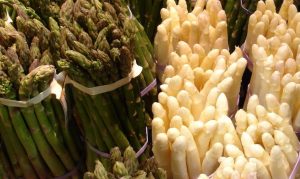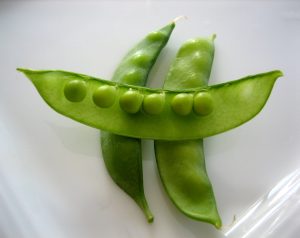Learn about an array of seasonal spring vegetables from our Dietician Carol Valle, including their nutritional value and how to cook them. Watch the video or read the transcript.
Subscribe to our YouTube Wellness Channel.
Hi, I am Carol Valle, Carroll Lutheran Village’s registered dietician, and this month we are going to talk about spring vegetables. As our thoughts turn to early spring, we’re always looking for those farmer markets and roadside stands to start opening up again! We are going to look at some of the spring vegetables you can find at the markets, and some interesting ones I thought I’d share with you.
Amazing Artichokes, The Trendsetting Vegetable
Our first vegetable, which is amazing, is artichokes! Granted, these little vegetables are not the most common spring vegetable; it’s not a food most of us routinely eat. The first time I had an artichoke was after I got married. I never had an artichoke until my mother-in-law made me one. She makes stuffed artichokes, and they are delicious.
Artichokes are a Thistle
Artichokes are actually a thistle and if the vegetable is not picked, it will turn into a big purple flower thistle.
This particular spring vegetable, or thistle, originated in the Mediterranean. It’s very high in fiber, almost 25% of your fiber requirements can be met with eating one artichoke. Not only is this a great source for fiber, but artichokes are loaded with a lot of vitamins and minerals. As most produce that grow in the ground are naturally loaded with minerals, artichokes are exceptionally high. One artichoke is about 60 calories, though the calorie level can increase depending on how it’s prepared.
Ways to Eat Artichokes and the Time it Takes
Artichokes can be very time-consuming to prepare, but it’s worth the time. There are many interesting ways to eat them including steamed, boiled, roasted, sautéed and, as I like them best, stuffed!
To stuff an artichoke, you need to spread the leaves open far enough to rinse them, cut off the top and spread the leaves apart so you can stuff the leaves with bread crumbs, cheeses, garlic and olive oil. Then set it in a pot and cook it for about four hours. It really is delicious when ready; worth the preparation and wait! When making a stuffed artichoke, the ingredients add quite a bit of calories.
Artichokes are the perfect side vegetable for special occasions. If you have a special occasion in the spring, you’re in luck. Artichokes are sold from February through June, but April and May are the best months to purchase the vegetable.
Don’t Forget Asparagus

Green and White Asparagus
Asparagus is such a great spring vegetable that it is not pictured in the video, it was in the refrigerator and it looked so good it was prepared for last night’s dinner. Asparagus is a classic spring vegetable, I am sure we can all picture it.
All About Asparagus
Asparagus is a flowering plant that originated in Europe and Western Asia. We eat the little shoots that come up from the ground. We eat these shoots in spring when they are small and fresh. This spring vegetable is low in calories, and similar to an artichoke, it is a good source of fiber, is full of vitamins and minerals and can be prepared in many ways. Asparagus can be steamed, roasted, grilled, stir-fried, pickled and sautéed as well as it can be added to soups and stews.
White and Green Asparagus
White asparagus is grown exactly like green asparagus except it is fully covered by soil. Because farmers never expose white asparagus to sunlight, there is no photosynthesis, so the vegetable never turns green. White asparagus is just green asparagus that was grown underground. Since white asparagus is grown differently, it is more expensive than green asparagus because it costs more to harvest it. Farmers have to dig it up to harvest it as opposed to simply cutting green asparagus.
I am sure you will see quite a bit of asparagus on our menu this spring as it is sold from February through June. The most popular time for asparagus is April and May.
Carrots Are Anything but Boring
We have interesting carrots here! Carrots come in a variety of colors including white, yellow, orange, red and purple. Carrots may also have two different shades, such as purple carrots. The difference in color is due to the different skin pigment, but there isn’t much difference in taste and texture. Purple carrot, when cut open, has a bit of white in the middle and the rest is purple. The taste, at least to me, is similar to an orange carrot.
Carrots are highly nutritious. A very good source of beta-carotene and vitamin K. You often hear people saying eating carrots is good for your eyesight because of the vitamin K, along with the vitamins A and B, it contains. The benefits do not stop there, it is another great source of fiber.
On our side of the world, we usually see the orange and yellow carrots. In eastern areas, like Asia, the purple and red carrots are more common. There are even black carrots, but I could not find one of those shades for today.
A year round spring vegetable, you can find carrots all no matter where and when you are food shopping. This spring vegetable can be eaten raw or cooked.
Fennels, a Flowering Plant for the Season
The next spring vegetable, that looks like a bulb, is a Fennel. This vegetable has a “bulby” looking shape because it is a flowering plant. If not picked, it will grow little yellow flowers at the top. It is part of the carrot family, but unlike carrots, it does not grow underground. The fennel ball grows above ground!
The Nutritious Licorice
Fennel is found in the Mediterranean and has a mild licorice-like flavor. However, it’s seeds have a very potent licorice flavor that’s great for flavoring sausages. Fennel is a great source of vitamins C and K and fiber.
Getting the Most and Best Out of Fennel
You can eat the bulb and up to the middle of the stalks. The stalks are very fibrous. Everything I read says they are not good to cook, so people use the little fronds to season soups and stews or to top off a salad. With the bulb chopped, you can braise, sauté, roast and grill it. Again, you have to like the taste of licorice because it does have a mild taste of licorice.
This is harvested October through May. The market I went to just had a huge selection of fennel. I am going to have to cook this, and see what it tastes like!
Leeks, the Other Onion
Leeks are a vegetable that are part of the allium family, which is the same family as onions, garlic, chives and shallots. Leeks look just like a gigantic green onion! It is sweeter than most onions. Leeks are rich in antioxidants; they can contain a little bit of vitamins K and A but mostly a lot of different minerals, and they are a very good source of fiber.
You can eat these raw or cooked. When eaten raw they are really crunchy and a little bit tough to get through, they are much better if they are cooked or sautéed. I often see leeks added to potato or leek and asparagus soups because it gives a mild onion flavor to the soups. You can also sauté leeks; tonight I am going to try it and see how that works!
Leeks are best in the spring – right now – and then again in the fall.
More Peas, Please
Next on our list are peas! There are three different kinds of peas. The peas you typically think of including those that are shelled, which are bought frozen or canned, or shelled, which are common in the spring. Then you have these little peas, and then the peas in between.
Vegetable or Not
Typical peas are technically not a vegetable; they are actually part of the legume family, the same family of lentils, chickpeas, peanuts and beans. They are seeds within a pod, and the pod is tough – you cannot eat it, you have to shell the peas. They are high in carbohydrates and have a nutrition profile that is closer to a potato or corn than the other spring vegetables. The other spring vegetables tend to be very low calorie and not starchy.
The peas you buy at the grocery store are typically green, but you can also buy yellow peas, black-eyed peas and even find purple peas! A half cup of peas is about 60 calories. You would probably have to eat four leeks to get 60 calories. Peas are a more calorie-dense food and have a little bit of protein. They are higher in protein than most vegetables because they are legumes. Fresh peas are common from March through May, but most people buy peas frozen, canned or even dried.
Snow Peas and Sugar Snack Peas

Snow Peas
Now snow and sugar snack peas have a different nutrient profile than the typical peas. They are low in carbohydrates when compared to typical peas. The snow peas are flatter. You can see that the little peas inside are very immature little, tiny peas. Typically, you sauté them or eat them raw – you see these in a lot of Chinese or Asian cooking.
The sugar snap pea pods are thicker when compared to typical peas. Sugar snap pods are edible! It is recommended that you pull the pod off, but because it’s very tender don’t have to. Sometimes there is a little string you can use to pull it off. If you do not like to eat the pod, they are easy to snap open. When opened, you can see the peas inside are very small and immature.
Easy to Prepare
These peas are often eaten raw, but you can cook either one. They cook very quickly so quick sauté or heat up will do. If you microwave them, you will find that they shrink into just about nothing.
Last but Not Least, Fingerling Potatoes
I did not take the Fingerling Potatoes out of the container. There is some new potatoes, purple ones and little ones!
What makes potatoes or what gives them the name “new” is when they are harvested. New potatoes are harvested about eight to ten weeks after they are planted, when they are very small and tender.
Thank you for tuning in, and be on the lookout for our new menu items featuring some of these spring vegetables. If you are interested in learning about more wonderful foods and recipes, see more of my nutrition articles.
